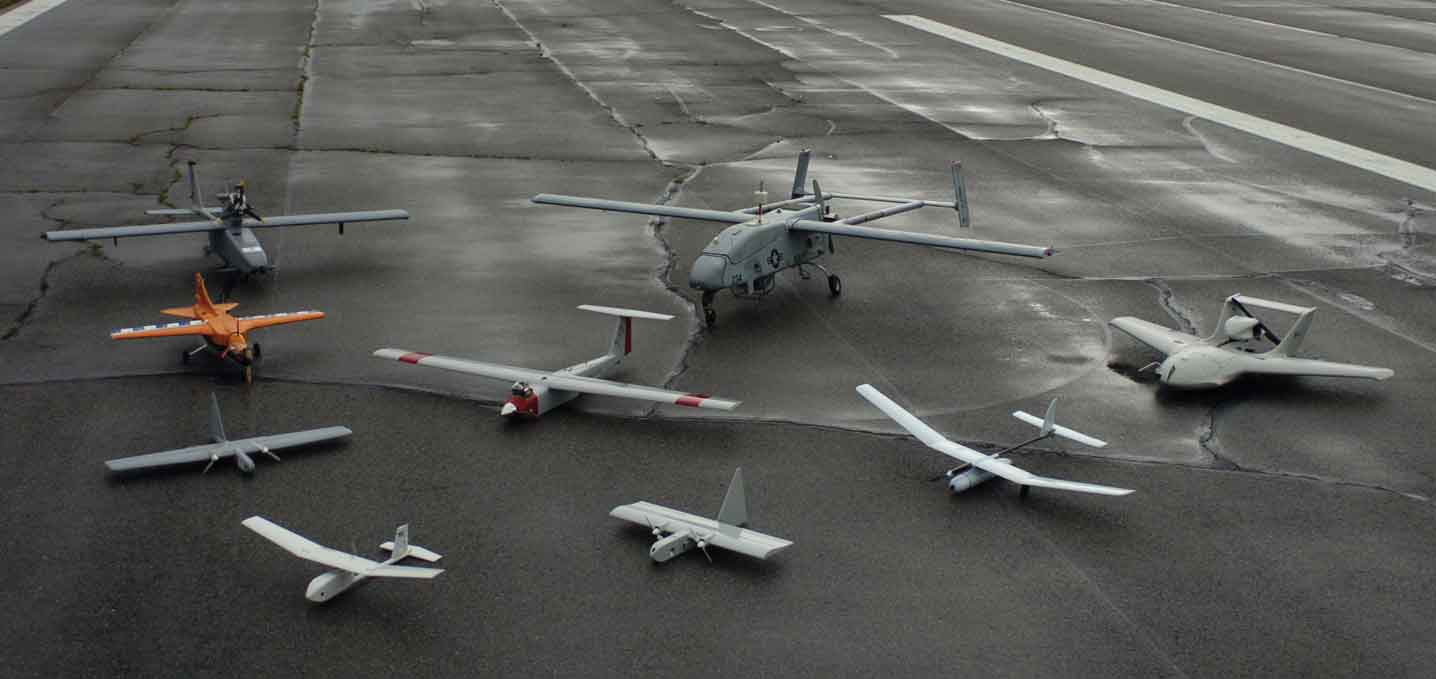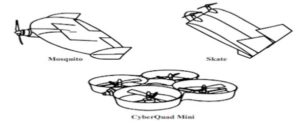
Various Unmanned Aerial Vehicles. Pictured are (front to back, left to right) RQ-11A Raven, Evolution, Dragon Eye, NASA FLIC, Arcturus T-15, Skylark, Tern, RQ-2B Pioneer, and Neptune.
Unmanned Aerial Vehicles (UAVs), also known as drones, are aircraft that do not carry any crew, but rather, are operated remotely by human operators, or autonomously via pre-programmed software or robots. UAVs vary widely in size and capacity, and have become increasingly prevalent. Their use has increased exponentially over the last decade for a broad range of applications, including cartography and mapping, inspection of remote power lines and pipelines, delivery services, telephone communications relay, police surveillance, tfc monitoring, border patrolling and recce, and emergency and disaster monitoring.
The use of mini-UAVs has increased exponentially over the last decade for a broad range of applications. The recent commercial availability of a new generation of small UAVs has emphasised the growing threat posed by these machines. There is a need for reviewing the security threats posed by mini-UAVs in areas such as terrorist attacks, illegal surveillance and recce, smuggling, electronic snooping, and mid-air collisions. The categories of mini-UAV intrusions in terms of intention and level of sophistication of the operators vary and thus keeping in view these mini-UAVs there is a need to formulate AD solutions for these multi-dimensional air threats.
Classification of Drones / UAVs. Terms like Drone, Remotely Piloted Vehicle (RPV),Remotely Piloted Aircrafts (RPA), UAV and Unmanned Aerial System (UAS) are the different nomenclature for the unmanned aircraft and have been use indifferent times but, all these terms mean the same. Secondly, there is no one standard when it comes to the classification of RPA’s. These can be classified by various parameters such as their size, endurance and range, maximum altitude, wing loading, engine type and power and thrust load. Since the study pertains to the counter measures against the RPA’s threat, the size and altitude of operation and speed would be the relevant factors for consideration. UAVs may be classified according to their size as follows :-
- Very Small UAVs
– Micro or Nano UAVs.
– Mini UAVs.
- Small UAVs.
- Medium UAVs.
- Large UAVs.
Very Small UAVs Micro and mini UAVs are the smallest in UAV technology with dimensions ranging from the size of a large insect to 30-50 cm long. These drones can fly at low altitudes that are below 300 meters. These micro and mini UAVs can carry little and lighter things such as listening and recording devices. Transmitters and cameras can also be carried by mini UAVs. Micro UAVs are smaller as compared to mini UAVs. The wt of the mini UAVs is less than 30 kgs and is best suited for commercial applications. Security agencies can use these for spying etc. Some commonly used mini-UAVs are as shown in Fig.
 Easy Availability The fact that even small payloads can cause significant damage may lead to the conclusion that the most likely threat may occur from mini-UAVs. The most worrisome sit stems from model ac, where uncontrolled access to the knowledge, skills, and equipment required for mini-UAV assembly exists. Modelers are currently able to assemble vehicles with capabilities that used to be achievable only by professional teams. Not only are production-run accessories and separate parts such as engines, radio controls, servos, flights tab system, and GPS receivers currently available commercially, but a wide spectrum of ready-to-fly aircraft kit models are on the market. Some models require experience in piloting, but other aircraft that are simple and stable in flight are produced specifically for beginners. Therefore, relatively simple designs that are stable in flight may be used. UAV control and delivery to a target is a more complex task, but this task is not beyond power of nonprofessionals. The most imp element-prep of an aerial vehicle for a terrorist attack, includingassembly and tests-can be done legally, because such activity is not regulated or cont.
Easy Availability The fact that even small payloads can cause significant damage may lead to the conclusion that the most likely threat may occur from mini-UAVs. The most worrisome sit stems from model ac, where uncontrolled access to the knowledge, skills, and equipment required for mini-UAV assembly exists. Modelers are currently able to assemble vehicles with capabilities that used to be achievable only by professional teams. Not only are production-run accessories and separate parts such as engines, radio controls, servos, flights tab system, and GPS receivers currently available commercially, but a wide spectrum of ready-to-fly aircraft kit models are on the market. Some models require experience in piloting, but other aircraft that are simple and stable in flight are produced specifically for beginners. Therefore, relatively simple designs that are stable in flight may be used. UAV control and delivery to a target is a more complex task, but this task is not beyond power of nonprofessionals. The most imp element-prep of an aerial vehicle for a terrorist attack, includingassembly and tests-can be done legally, because such activity is not regulated or cont.
Mini-UAV as an Air Threat
From a mil perspective, UAVs, which can be recoverable or expendable, are generally used to op in dangerous or hostile territories, without endangering the operators. It is employed for surveillance and recce, info collection, detection of mines, and for combat purposes. UAVs hold many attractions for the mil. They are generally smaller, lighter and cheaper as compared to manned aerial vehicles as they do not need equipment to support a crew. UAVs can also be used for many hours in a stretch, while switching operators. The recent commercial availability of a new generation of small UAVs, often quad-copters or some other form of rotorcraft, has emphasised the growing threat posed by these machines. These UAVs can be easily purchased over the internet and can carry a payload of up to a few kgs. They are cheap, easy to fly and small enough to evade traditional security surveillance. A recreational UAV costing a few hundred dollars can be turned into an aerial equivalent of an improvised explosive device (IED), or be equipped with a cam and data downlink to become a spy UAV.
Security Threats On 25 Jan 2015, a small UAVs, Quad-copter which weighed about two pounds, op by a hobbyist crashed in White House at around 3 a.m. after its operator lost its cont. The White House radar system which is designed to detect flying objects like planes, missiles and large drones failed to pick up a small drone. As per a recent media report in India during past two years, there has been three sightings of drones near civil aircrafts. On 28 Jan 17, a serious near miss was reported by a pilot of Go Air aircraft which while approaching to land at Mumbai airport spotted a drone flying at 12000 ft AGL horizontally separated from the civil flight by just 2 km. This is potentially a dangerous flight safetysit which mortally risked the life of the air passengers. No. of similar near collisions has been reported by International Air Tpt Association (IATA) worldwide between manned aircraft with drones. Nearly 100 UAV sightings are reported every month by the manned aircraft in their vicinity. Hence, flight safety is a major concern with unregulated UAV flying .
Mini-UAVs as a Potent Wpn There are innumerable ways in which a Mini-UAV can be used as a wpn.
- Comb Wpns. An attacker could use a UAV to spray a weaponised chemical or biological agent over a crowd of people.
- Target Designation. An operator could also use a UAV to reconnoitertargets for attack.
- Surveillance. To monitor the actions of indls or law enforcement.
- Smuggling. To smuggle illicit material, usually across borders or into prisons.
- Electronic Snooping. Mini-UAVs can also be used for electronic snooping. At the Black Hat security conference held in Singapore, SensePost unveiled its Snoopy mini-UAV, which can steal data from unsuspecting smartphone users. The mini-UAV uses the company’s software, which is installed on a Computer attached to a UAV. The code can be used to hack smartphones and steal personal data without the user’s knowledge. This method could be used to particular effect in a crowded environment where many people have their cell phones auto searching for Wi-Fi networks.
- Destruction of Aerial Targets. Pilots have expressed concern regarding the proliferation of commercially available small UAVs. If a UAV got into the engine of an aeroplane, it could stop the engine. Heptr pilots have reported several near-miss incidents with UAVs.
- Jamming. Jamming of electronic devices.
- Misc.
– Public Nuisance.
– Infringement of privacy of a person.
– IED/ Explosives.
– Electronic Attack
Advantages to Terrorist for Mini-UAV as a Potent Wpn. A set of advantages that make UAVs attractive to terrorists as a potent wpn are:-
- Possibility to attack targets that are difficult to reach by land.
- Possibility of carrying out a wide-scale attack aimed at inflicting a maximum death rate on a population.
- Covertness of attack prep and flexibility in choice of a UAV launch site.
- Possibility of achieving a long rg and acceptable accuracy with relatively inexpensive and increasingly available tech.
- Poor effectiveness of existing air defences against targets such as low-flying UAVs.
- Relative cost effectiveness of UAVs as compared with ballistic msls and manned airplanes.
- Possibility of achieving a strong psychological effect by scaring people and putting pressure on politicians.
- Possibility of achieving a strong psychological effect by remaining incognito.
AD Solutions to Multi-Dimensional Air Threats
After having a brief over view of the mini-UAV emerging as a potent threat and considering the above threat along with the existing air threats, there is a need to look at AD solutions for multi-dimensional air threats. The solution must encompass comps from the Air Force also with the overall AD responsibility remaining with the Air Force. Jtplg ,coord and synergy between the tri-services is essential for the overall AD of the nation.
Some of the solutions against mini-UAVs being in vogue in the developed nations are as under:-
- Geofencing.
- Radar Detection System.
- Acoustic Sensing.
- RF Emission Sensing.
- EO Sensing.
- Command Link Jamming and Appropriation.
- Spoofing.





Excellent read…. waiting for more articles from the author
Excellent article giving insight into functioning of UAV and potentials of mini-UAV.